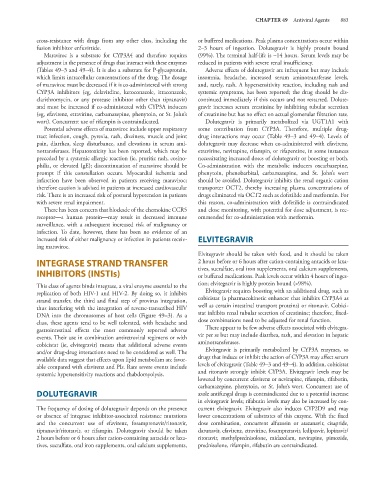Page 897 - Basic _ Clinical Pharmacology ( PDFDrive )
P. 897
CHAPTER 49 Antiviral Agents 883
cross-resistance with drugs from any other class, including the or buffered medications. Peak plasma concentrations occur within
fusion inhibitor enfuvirtide. 2–3 hours of ingestion. Dolutegravir is highly protein bound
Maraviroc is a substrate for CYP3A4 and therefore requires (99%). The terminal half-life is ~14 hours. Serum levels may be
adjustment in the presence of drugs that interact with these enzymes reduced in patients with severe renal insufficiency.
(Tables 49–3 and 49–4). It is also a substrate for P-glycoprotein, Adverse effects of dolutegravir are infrequent but may include
which limits intracellular concentrations of the drug. The dosage insomnia, headache, increased serum aminotransferase levels,
of maraviroc must be decreased if it is co-administered with strong and, rarely, rash. A hypersensitivity reaction, including rash and
CYP3A inhibitors (eg, delavirdine, ketoconazole, itraconazole, systemic symptoms, has been reported; the drug should be dis-
clarithromycin, or any protease inhibitor other than tipranavir) continued immediately if this occurs and not restarted. Dolute-
and must be increased if co-administered with CYP3A inducers gravir increases serum creatinine by inhibiting tubular secretion
(eg, efavirenz, etravirine, carbamazepine, phenytoin, or St. John’s of creatinine but has no effect on actual glomerular filtration rate.
wort). Concurrent use of rifampin is contraindicated. Dolutegravir is primarily metabolized via UGT1A1 with
Potential adverse effects of maraviroc include upper respiratory some contribution from CYP3A. Therefore, multiple drug-
tract infection, cough, pyrexia, rash, dizziness, muscle and joint drug interactions may occur (Table 49–3 and 49–4). Levels of
pain, diarrhea, sleep disturbance, and elevations in serum ami- dolutegravir may decrease when co-administered with efavirenz,
notransferases. Hepatotoxicity has been reported, which may be etravirine, nevirapine, rifampin, or rifapentine, in some instances
preceded by a systemic allergic reaction (ie, pruritic rash, eosino- necessitating increased doses of dolutegravir or boosting or both.
philia, or elevated IgE); discontinuation of maraviroc should be Co-administration with the metabolic inducers oxcarbazepine,
prompt if this constellation occurs. Myocardial ischemia and phenytoin, phenobarbital, carbamazepine, and St. John’s wort
infarction have been observed in patients receiving maraviroc; should be avoided. Dolutegravir inhibits the renal organic cation
therefore caution is advised in patients at increased cardiovascular transporter OCT2, thereby increasing plasma concentrations of
risk. There is an increased risk of postural hypotension in patients drugs eliminated via OCT2 such as dofetilide and metformin. For
with severe renal impairment. this reason, co-administration with dofetilide is contraindicated
There has been concern that blockade of the chemokine CCR5 and close monitoring, with potential for dose adjustment, is rec-
receptor—a human protein—may result in decreased immune ommended for co-administration with metformin.
surveillance, with a subsequent increased risk of malignancy or
infection. To date, however, there has been no evidence of an
increased risk of either malignancy or infection in patients receiv- ELVITEGRAVIR
ing maraviroc.
Elvitegravir should be taken with food, and it should be taken
INTEGRASE STRAND TRANSFER 2 hours before or 6 hours after cation-containing antacids or laxa-
INHIBITORS (INSTIs) tives, sucralfate, oral iron supplements, oral calcium supplements,
or buffered medications. Peak levels occur within 4 hours of inges-
This class of agents binds integrase, a viral enzyme essential to the tion; elvitegravir is highly protein bound (>98%).
replication of both HIV-1 and HIV-2. By doing so, it inhibits Elvitegravir requires boosting with an additional drug, such as
strand transfer, the third and final step of provirus integration, cobicistat (a pharmacokinetic enhancer that inhibits CYP3A4 as
thus interfering with the integration of reverse-transcribed HIV well as certain intestinal transport proteins) or ritonavir. Cobici-
DNA into the chromosomes of host cells (Figure 49–3). As a stat inhibits renal tubular secretion of creatinine; therefore, fixed-
class, these agents tend to be well tolerated, with headache and dose combinations need to be adjusted for renal function.
gastrointestinal effects the most commonly reported adverse There appear to be few adverse effects associated with elvitegra-
events. Their use in combination antiretroviral regimens or with vir per se but may include diarrhea, rash, and elevation in hepatic
cobicistat (ie, elvitegravir) means that additional adverse events aminotransferases.
and/or drug-drug interactions need to be considered as well. The Elvitegravir is primarily metabolized by CYP3A enzymes, so
available data suggest that effects upon lipid metabolism are favor- drugs that induce or inhibit the action of CYP3A may affect serum
able compared with efavirenz and PIs. Rare severe events include levels of elvitegravir (Table 49–3 and 49–4). In addition, cobicistat
systemic hypersensitivity reactions and rhabdomyolysis. and ritonavir strongly inhibit CYP3A. Elvitegravir levels may be
lowered by concurrent efavirenz or nevirapine, rifampin, rifabutin,
carbamazepine, phenytoin, or St. John’s wort. Concurrent use of
DOLUTEGRAVIR azole antifungal drugs is contraindicated due to a potential increase
in elvitegravir levels; rifabutin levels may also be increased by con-
The frequency of dosing of dolutegravir depends on the presence current elvitegravir. Elvitegravir also induces CYP2D9 and may
or absence of integrase inhibitor-associated resistance mutations lower concentrations of substrates of this enzyme. With the fixed
and the concurrent use of efavirenz, fosamprenavir/ritonavir, dose combination, concurrent alfuzosin or atazanavir, cisapride,
tipranavir/ritonavir, or rifampin. Dolutegravir should be taken darunavir, efavirenz, etravirine, fosamprenavir, ledipasvir, lopinavir/
2 hours before or 6 hours after cation-containing antacids or laxa- ritonavir, methylprednisolone, midazolam, nevirapine, pimozide,
tives, sucralfate, oral iron supplements, oral calcium supplements, prednisolone, rifampin, rifabutin are contraindicated.

